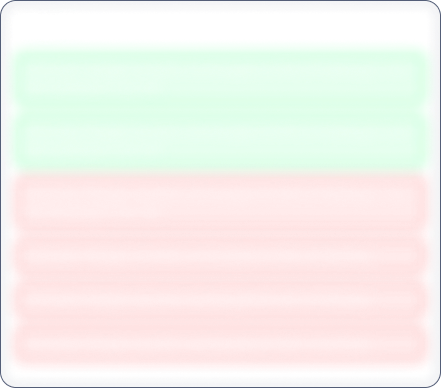Year End Sale 50% off
Global Surfaces

No Data Available
Investor Sentiment
Global Surfaces Share price and Fundamental Analysis
Key Metrics
Stock Returns
Stock Heatmap

No Stocks
Smart Score

Unlock Smart Score
See Detailed Analysis & Insights


Unlock Insights
See Detailed Analysis & Insights
Technicals
Returns Calculator
If you would have investedResearch Report
No Research Report
Corporate Action
Financials
Key Ratios
ROE
Avg ROE (3 Yrs) : NaN%
ROCE
Avg ROCE (3 Yrs) : NaN%
ROA
Avg ROA (3 Yrs) : NaN%
NPM
Avg NPM (3 Yrs) : NaN%
Dividend History
5 Year FactSheet
Documents

No Data Available
News
Global Surfaces Management and History
Company Management


Unlock Management Data
See Detailed Analysis & Insights
Company History
Global Surfaces Ltd was incorporated as 'Swastic Niwas Private Limited' on August 23, 1991 at West Bengal. Subsequently, name of the Company changed to 'Global Stones Private Limited' on May 17, 2004. The name of Company was changed to 'Global Surfaces Private Limited' pursuant to a Special Resolution passed by shareholders of the Company on October 07, 2021. Thereafter, Company converted into a Public Limited under the name 'Global Surfaces Limited' on October 07, 2021 and a fresh Certificate of Incorporation dated October 21, 2021 was issued by the Registrar of Companies, Jaipur.
The Company is engaged in the business of processing natural stones and manufacturing engineered quartz. The Company has application in flooring, wall cladding, countertops, cut-to size and other items. It has 2 units, one located at Bagru, Rajasthan and the other at Mahindra World City SEZ, Jaipur for processing and manufacturing of their products. The Unit I was acquired as processing natural stones such as marble, granite and quartzite, which helps in sourcing raw materials and minimize logistics and transportation cost.
Prior to acquisition of Unit I in 2004, the Company was engaged in real estate construction business in which it ceased to undertake. It upgraded their plant and machinery installed at Unit I in year, 2015. From onwards FY 2017-18, the Company further diversified their business of Unit II located at Sanganer (Jaipur) for undertaking business of manufacturing engineered quartz. It started production of engineered quartz at Unit II in the year 2018.
In 2020, the Company installed solar panels in both units as part of the Go Green Initiative and implemented ERP system. It incorporated Global Surfaces FZE, a wholly owned subsidiary in U.A.E. In 2022, it commenced construction of Proposed Facility at The Jebel Ali Free Zone, Dubai, U.A.E.
Global Surfaces Share Price
Global Surfaces share price reflects investor sentiment toward the company and is impacted by various factors such as financial performance, market trends, and economic conditions. Share price is an indicator which shows the current value of the company's shares at which buyers or sellers can transact.
Global Surfaces Market Cap
Market capitalization of Global Surfaces indicates the total value of its outstanding shares. Marketcap is calculated by multiplying share price and outstanding shares of the company. It is a helpful metric for assessing the company's size and market Valuation. It also helps investors understand how Global Surfaces is valued compared to its competitors.
Global Surfaces PE Ratio
Global Surfaces PE ratio helps investors understand what is the market value of each stock compared to Global Surfaces 's earnings. A PE ratio higher than the average industry PE could indicate an overvaluation of the stock, whereas a lower PE compared to the average industry PE could indicate an undervaluation.
Global Surfaces PEG Ratio
The PEG ratio of Global Surfaces evaluates its PE ratio in relation to its growth rate. A PEG ratio of 1 indicates a fair value, a PEG ratio of less than 1 indicates undervaluation, and a PEG ratio of more than 1 indicates overvaluation.
Global Surfaces ROE (Return on Equity)
Return on Equity (ROE) measures how effectively Global Surfaces generates profit from shareholders' equity. A higher ROE of more than 20% indicates better financial performance in terms of profitability.
Global Surfaces ROCE (Return on Capital Employed)
Return on Capital Employed (ROCE) evaluates the profitability of Global Surfaces in relation to its capital employed. In simple terms, ROCE provides insight to investors as to how well the company is utilizing the capital deployed. A high ROCE of more than 20% shows that the business is making profitable use of its capital.
Global Surfaces Total Debt
Total debt of Global Surfaces shows how much the company owes to either banks or individual creditors. In simple terms, this is the amount the company has to repay. Total debt can be a very useful metric to show the financial health of the company. Total debt more than equity is considered to be a bad sign.
Global Surfaces Debt to Equity Ratio
The Debt-to-Equity (DE) ratio of Global Surfaces compares its total debt to shareholders' equity. A higher Debt to Equity ratio could indicate higher financial risk, while a lower ratio suggests that the company is managing its debt efficiently.
Global Surfaces CAGR (Compound Annual Growth Rate)
CAGR shows the consistent growth rate of Global Surfaces over a specific period, whether it is over a month, a year, or 10 years. It is a key metric to evaluate the company’s long-term growth potential. Main metrics for which CAGR is calculated are net sales, net profit, operating profit, and stock returns.
Global Surfaces Technical Analysis
Technical analysis of Global Surfaces helps investors get an insight into when they can enter or exit the stock. Key components of Global Surfaces Technical Analysis include:
Support Levels (S1, S2, S3)
There are usually multiple support levels, but the main support levels for a stock are S1, S2, S3. Support levels indicate price points where stock might get support from buyers, helping the stock stop falling and rise.
Resistance Levels (R1, R2, R3)
There are usually multiple resistance levels, but the main resistance levels for a stock are R1, R2, R3. Resistance levels represent price points where Global Surfaces shares often struggle to rise above due to selling pressure.
Global Surfaces Dividends
Dividends refer to the portion of the company’s profits distributed to its shareholders. Dividends are typically paid out in cash and reflect Global Surfaces ’s financial health and profitability.
Global Surfaces Bonus Shares
Bonus shares are usually given by companies to make the stock more affordable, increase liquidity, boost investor confidence, and more.
Global Surfaces Stock Split
Stock split increases the number of its outstanding shares by dividing each existing share into multiple shares. When the company offers a stock split, the face value of the stock reduces in the same proportion as the split ratio.
Global Surfaces Financials
The financials of Global Surfaces provide a complete view to investors about its net sales, net profit, operating profits, expenses, and overall financial health. Investors can analyze financial data to assess the company’s stability and also understand how the company has been growing financially.
Global Surfaces Profit and Loss Statements
The profit and loss statement of Global Surfaces highlights its net sales, net profit, total expenditure, and operating profits in the current financial year. This Profit and Loss statement is crucial for evaluating the profitability and financial stability of Global Surfaces .
Global Surfaces Balance Sheet
The balance sheet presents a snapshot of Global Surfaces ’s assets, liabilities, and equity of shareholders, providing insights into the financials of the company.
Global Surfaces Cashflow Statements
Cashflow statements track the company's cash inflows and outflows over a period. It is an essential tool for understanding how well the company manages its liquidity and finances.


